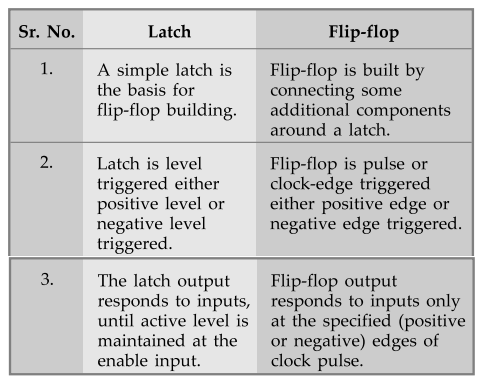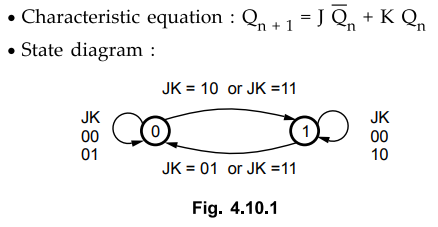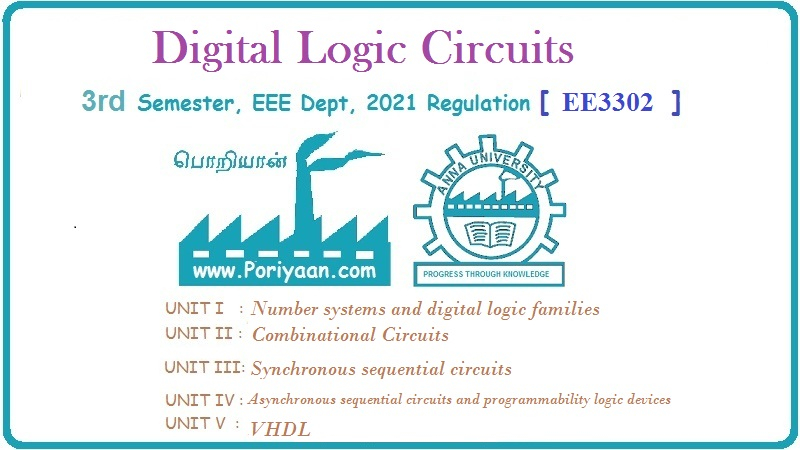Digital Logic Circuits: Unit III: (a) Flip-Flops
Two Marks Questions with Answers
Flip-Flops | Digital Logic Circuits
Digital Logic Circuits: Unit III: (a) Flip-Flops : Two Marks Questions with Answers
Two Marks Questions with Answers
Q.1
Define a sequential logic circuit. Give an example.
AU
: May-08
Ans.
:
The circuits in which the output variables depend not only on the present input
but they also depend upon the past history of these input variables are known
as sequential logic circuits. Flip-flops, counters, registers are the examples
of sequential logic circuit.
Q.2
What are synchronous sequential circuits ?
AU
: May-10, 14
Ans.
:
Synchronous sequential circuits are those in which signals can affect the
memory elements only at discrete instants of time. Clocked flip-flops are
examples of synchronous sequential circuits.
Q.3
Differentiate between combinational and sequential circuits. (Refer section
4.1.1)
Q.4
Differentiate between flip-flop and latch.
Ans
. :

Q.5
Give the meaning for edge triggering in flip-flops.
Ans.
:
In the edge triggering, the output responds to the changes in the input only at
the positive or negative edge of the clock pulse at the clock input. There are
two types of edge triggering.
•
Positive edge triggering : Here, the output responds to the
changes in the input only at the positive edge of the clock pulse at the clock
input.
•
Negative edge triggering : Here, the output responds to the
changes in the input only at the negative edge of the clock pulse at the clock
input.
Q.6
Draw the circuit of SR flip-flop. AU : May-10
(Refer
section 4.2)
Q.7
Draw the logic circuit of a clocked JK flip-flop.
(Refer
section 4.4)
Q.8
What is the operation of D flip-flop ?
Ans.
:
In D flip-flop during the occurrence of clock pulse if D = l, the output Q is
set and if D = 0, the output is reset.
Q.9
Draw truth table for JK flipflop.
(Refer
Fig. 4.4 (c))
Q.10
What is the operation of JK flip-flop ?
Ans.
:
•
When K input is low and J input is high the Q output of flip-flop is set.
•
When K input is high and J input is low the Q output of flip-flop is reset.
•
When both the inputs K and J are low the output does not change
•
When both the inputs K and J are high the output toggle on the next positive
clock edge.
Q.11
What is the operation of T flip-flop ?
Ans.
:
T flip-flop is also known as Toggle flip-flop.
•
When T = 0 there is no change in the output.
•
When T = 1 the output switch to the complement state (i.e.) the output toggles.
Q.12
With reference to a JK flip-flop, what is racing ?
AU
: May-04, Dec.-08, 11, 17
Ans.
:
In a level triggered J-K flip-flop, when J and K are both high, then the output
toggles continuously. This condition is called a race around condition.
Q.13
What is a master-slave flip-flop ?
Ans.
:
A master-slave flip-flop consists of two flip-flops where one circuit serves as
a master and the other as a slave. The output of the master flip-flop is fed as
an input to the slave flip-flop. The master flip-flop is triggered at the
positive edge of the clock and slave flip-flop is triggered at the negative
edge of the clock.
Q.14
Give the characteristic equation and state diagram of JK flip-flop.
Ans.
:

Q.
15 If the input frequency of a T FF is 1600 kHz, what will be the output
frequency ? Give reason for your answer.
Ans.
:
800 kHz, because it toggles at every clock pulse.
Q.
16 Give the excitation table of SR flip-flop.
(Refer
section 4.8.3.1)
AU
: Dec.-03
Q.
17 Give the excitation table for JK flip-flop.
(Refer
section 4.8.3.2) I
AU
: May-05, 06, June-09
Q.
18 Obtain the excitation table of D and JK flip-flops.
(Refer
sections 4.8.3.3 and 4.8.3.2) I
Q.
19 Give the state diagram of JK FF.
(Refer
section 4.8.2)
AU
: May-07, 10, Dec.-12
Q.
20 Convert JK FF to D FF. (Refer section 4.9.5)
Q.21
The JK flip-flop is an universal flip-flop. Justify.
AU
: Dec.-12
Ans.
:
The JK flip-flop is called an universal flip-flop because it can be easily
configured to work as any other flip-flops such as T flip-flop, D flip-flop and
SR flip-flop.
Q.22
Define registers.
Ans.
:
A register is a group of flip-flops. So an n-bit register has a group of n
flip-flops and is capable of storing any binary information/number containing
n-bits.
Q.23
Define shift registers.
Ans.
:
The binary information in a register can be moved from stage to stage within
the register or into or out of the register upon application of clock pulses.
This type of bit movement or shifting is essential for certain arithmetic and
logic operations used in microprocessors. Ibis gives rise to group of registers
called shift registers.
Q.24
What are the different types of shift type ?
Ans.
:
There are five types. They are,
•
Serial In Serial Out Shift Register
•
Serial In Parallel Out Shift Register
•
Parallel In Serial Out Shift Register
•
Parallel In Parallel Out Shift Register
•
Bidirectional Shift Register
Q.25
What is the difference between serial and parallel transfer ? What type of
register is used in each case ?
AU
: Dec.-07
Ans.
:
When data is transferred one bit at a time, the process of transfer is known as
serial transfer. When multiple bits of data are transferred at a time, the
process is known as parallel transfer. For parallel transfer, we can use
parallel in and parallel out register. For serial transfer we can use left
shift or right shift register.
Q.26
What is the drawback of SR flip-flop
AU
: May-14
Ans.
:
For SR flip-flop, when SR inputs are S = R = 1, output is unpredictable. This
is the drawback of SR flip-flop.
Q.27
Show how the JK flip flop can be modified into a D flip flop or a T flip-flop.
(Refer sections 4.9.5 and 4.9.4) AU
: Dec.-14
Q.28
Mention the major application of master slave flip-flop. (Refer section 4.5) AU
: Dec.-l0
Q.29
Sketch the state diagram of D flip-flop. (Refer section 4.8)
AU
: Dec.-12
Q.30 Draw state diagram of SR flip-flop.
(Refer
section 4.8) AU : Dec.-l0
Q.31
Obtain the excitation table of D flip-flop.
(Refer
section 4.8) AU : May-06
Q.32
Convert JK flip-flop to T flip-flop.
(Refer
section 4.9) AU : Dec.-l0
Q.33
Draw the truth table and state diagram of SR flip-flop.
(Refer
section 4.2 and 4.8.2) AU : Dec.-15
Q.34
What is edge triggered flip-flops ?
(Refer
section 4.1.3) AU : Dec.-15
Q.35
Convert T Flip Flop to D flip-flop.
(Refer
section 4.9.7) AU : May-15
Q.36
Give the characteristic equation and characteristic table of SR flip-flop.
(Refer
Fig. 4.2.2) AU : May-16
Q.37
Draw the state diagram of JK flip flop.
(Refer
section 4.8.2) AU : Dec.-16
Q.38 Give the characteristic equation and characteristic table of a T Flip Flop. (Refer section 4.6) AU : May-17
Digital Logic Circuits: Unit III: (a) Flip-Flops : Tag: : Flip-Flops | Digital Logic Circuits - Two Marks Questions with Answers
Related Topics
Related Subjects
Digital Logic Circuits
EE3302 3rd Semester EEE Dept | 2021 Regulation | 3rd Semester EEE Dept 2021 Regulation
